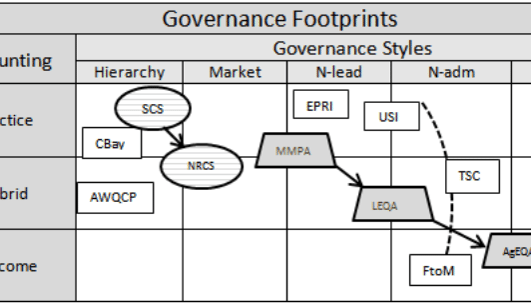

Economy
Agricultural Sustainability: Follow the Governance Footprints
“As toddlers in the field of economics, ag(ricultural) sustainability organizations are beginning to take their first governance footsteps…somewhere.” Writes Tim Gieseke, first published here, republished with permission.
A bit of organizational history; just a century ago most organizations relied on a hierarchy governance style – the typical top-down, command-and-control method. As the world become more complex and greater innovation was needed, a market governance style was adopted. Still top-down, but a bit more fluid to remain competitive. The most recent governance style to emerge is network governance – a more horizontal structure that is able to gather a quantity of information that would cause bottlenecks in the other two.
All governance styles are in use today, in fact, never before in human history has so many versions of governance existed side-by-side. And this has created a governance paradox; that is, there is inherent conflicts created among the governance styles, yet each is needed to address the complexity of ag sustainability (and all other wicked social problems).
The graphic above illustrates how some ag sustainability efforts are beginning to step away from hierarchy-based governance toward more progressive and inclusive governance styles (market and various forms of network governance). In researching these efforts, I believe these steps or shifts in organizational governance are mostly unconscious.
In brief, the USDA SCS has shifted from a predominantly hierarchy governance and practice-based accounting system to its slightly different NRCS version today that includes outcome-based accounting and market governance.
The three MMPA, LEQA, AgEQA projects represent a chronological evolution of state (MN) projects in industry, state and local governments that moved from practice-based to outcome-based accounting and trended toward a more inclusive network governance.
The final grouping consist of the EPA’s Chesapeake Bay TMDL, the USDA-EPA-AWQCP, Electric Power Research Institute WQ auction, United Suppliers SUSTAIN, Field-to-Market and The Sustainability Consortium. These fairly predominant efforts are in the early stages with their governance styles originating from within their organizational culture. A few small steps have taken by USI, TSC and FtoM to address the need for more data and inclusion of more stakeholders to achieve their goals.
For society to achieve its food and ag sustainability goals, these efforts and the hundreds not on the graphic will need to somehow coalesce and align their varied accounting strategies and resolve the inherent governance conflicts. That could take a long time.
Or the food and ag sustainability community could be provided with a multi-sided shared governance (MSSG) platform – similar to the business model (multi-sided platform) adopted by Uber, Airbnb, Alibaba, etc – but modified to address the complexity of landscape sustainability.
The MSSG Platform combines the low and diffuse values associated with ecosystem services and reduces and shares the high transaction costs of exchanging values. These are not just steps in the right governance direction, but are gigantic and scalable leaps to the next plateau in ag sustainability.
If you are interested in being part of the MSSG Platform, contact: tgieseke@agresourcestrategies.com


 Environment9 months ago
Environment9 months agoAre Polymer Banknotes: an Eco-Friendly Trend or a Groundswell?

 Environment11 months ago
Environment11 months agoEco-Friendly Home Improvements: Top 7 Upgrades for 2025

 Features8 months ago
Features8 months agoEco-Friendly Cryptocurrencies: Sustainable Investment Choices

 Features10 months ago
Features10 months agoEco-Friendly Crypto Traders Must Find the Right Exchange

















